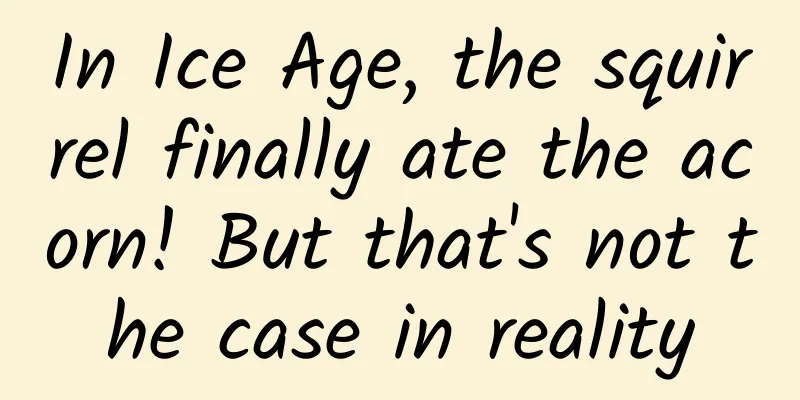In Ice Age, the squirrel finally ate the acorn! But that's not the case in reality

|
In Ice Age, Scrat the squirrel is probably the most memorable character. He is tenacious but unlucky, always looking for acorns but never able to eat them. Recently, the Ice Age production team, Blue Sky Studios, which closed last year, released a farewell animation. This time, the squirrel finally ate the acorn. Scrat the squirrel finally ate the acorn|Youtube: @Mr. Revelscron From the release of the first Ice Age movie in 2002 to today, 20 years later, Scrat and his acorn have been going through all kinds of love and hate, driving the plot forward. In reality, squirrels and acorns are also playing out similar stories. The Oak Tree Has a Secret Plan Scrat never gets to eat acorns. Perhaps it can be attributed to one thing: every time he gets an acorn, he doesn't eat it right away, but quickly finds a place to hide it. So he breaks the glacier, breaks through the ground, and breaks out the spaceship... This "grey wolf behavior" is obviously based on the squirrels in reality who like to store food. Squirrels store nuts as food for the winter, and the nuts that are hidden by the squirrels but not eaten break through the soil in the spring and grow into new seedlings. In this process, the squirrels are fed and the oak seeds are spread, so it is regarded as a typical example of mutualism. Squirrel hiding its acorns | Wandering Arctic Salamander Unfortunately, reality is not as good as it seems. The squirrel and the oak tree are in a predator-prey relationship, and they both have their own agenda and plan to "cross the line." The squirrel wants to eat more acorns, and the oak tree wants the squirrel to eat less acorns and work more, so the happy symbiotic relationship begins to hide mutual harm. Every acorn has the potential to grow into a new sapling, but according to the laws of nature, most of the acorns will be consumed by squirrels and other animals, which is obviously not good for the oak tree. Oak trees will not sit still and wait for death, they also have countermeasures. Just like squirrels hide acorns in different places, oak trees also know not to put all their eggs in one basket. Every 2 to 5 years, oak trees will suddenly produce a large number of fruits, and the yield can be several times the usual. This phenomenon is called a masting year. Faced with the sudden surge in food, the squirrels are very happy. They desperately want to hide more acorns. But because the base number is too large, the number of acorns that are not eaten also increases accordingly. The sudden "acorn gift package" made the squirrel feel a little flattered | Wandering Arctic Salamander Although squirrels will increase in number after a good harvest year, their lifespan is much shorter than that of oaks, and the population will gradually return to a low point after a good harvest year. This is the predator saturation effect, an anti-predator strategy that keeps the number of predators at a low level. Other examples include the large-scale flowering of bamboo and the life cycle of the 17-year cicada. However, how the dumb oak trees enter a good harvest year at the same time and in a large area is not clear, and it may be related to specific weather conditions. From this perspective, although squirrels eat acorns, they are controlled by the production of oak trees. In the first round, the squirrel was the worker mouse and the oak tree had the upper hand. Acorns aren't that tasty. Seeing Scrat eating the acorns with satisfaction, you might be curious, what delicious magic do acorns have that makes squirrels crazy about them? In the annual diet of the Eastern American squirrel (Sciurus carolinensis), seeds account for about 50% to 95%, and almost half of them are acorns. Although acorns are not the nuts with the highest calories, they are abundant and are an important food storage for squirrels. However, in spring, the seeds buried in the soil will germinate, making spring the most difficult season for squirrels. The nutritional value of acorns is greatly reduced as they germinate, so squirrels will not eat them and can only gnaw on flowers, buds and other foods to survive. To counter this, squirrels sometimes bite off the base of an acorn when it is buried, destroying the embryo and preventing it from germinating. This behavior is innate and squirrels do not need to learn how to do it. Squirrels nibbling on black willow flower buds | Wandering Arctic Salamander Oak trees have a solution to this problem, and the secret is the tannins in the acorns. Tannins not only ensure that the acorns are not infected by bacteria and fungi, but also protect against squirrels - squirrels don't like the bitter taste of tannins, and consuming too much tannins will affect their digestion and absorption of nutrients. As a result, the base of the acorn (the "cap" end) contains more delicious lipids as a reward for squirrels to spread the seeds, while the other end is enriched with high concentrations of tannins to prevent squirrels from destroying the embryo. Even if part of the acorn is eaten, as long as the embryo is not destroyed, the acorn can still germinate. In the video, Scrat starts eating from the tip of the acorn, which is the part rich in tannins. This is probably a small bug. | Pixabay In the second round, the squirrel and the oak tree tied. PS: Tannin is also toxic to Homo sapiens, so it cannot be eaten directly. Some groups, such as Native Americans, will soak and wash acorns in water several times before eating them to remove tannin. The squirrel decides where the acorn lives The two most common types of oak trees (Quercus spp.) in North America, red oak (Lobatae group) and white oak (Quercus group), have different attitudes toward squirrels. Red oak is the type described above. Their acorns need to go dormant before they can germinate, and they are very dependent on squirrels for dispersal, so they contain more lipids and tannins. White oak acorns germinate soon after they mature, trying to avoid being preyed upon by squirrels as much as possible. However, because they contain less tannin, the squirrels' embryo cutting behavior creates a greater selection pressure on white oak, and the oak tree has to find another way. The battle of wits between the squirrel and the acorn | Wandering Arctic salamander This starts with the internal structure of the acorn. The flower of the oak tree has six ovules, and usually only one of them can develop into a seed. But in some oak trees in North America, multiple ovules can develop at the same time, forming a fruit containing multiple seeds, one of which will eventually germinate into a seedling. That is to say, when squirrels destroy the embryo of the acorn, they may not hit the ovule that eventually develops into a seedling, which reduces the success rate of squirrels cutting the embryo again and avoids "black rats digging out the heart". This method is so useful that many red oaks will also use this method to increase the survival rate of acorns. The tug-of-war between squirrels and oak trees isn't over yet | Pixabay Because of their ability to germinate quickly, white oaks tend to be more distributed in groups in the forest, while red oaks, which rely on squirrels to disperse their seeds, are more scattered. Given that squirrels feed on and disperse more plants than just oaks in the forest, squirrels' behavior ultimately affects the composition of the forest. In the third round, although the oak tree had the strategy of multiple ovules, their distribution was ultimately determined by the squirrels. In this round, the squirrels finally had the upper hand. Official stills from Ice Age 2002 | Ice Age “You have to keep running as hard as you can to keep yourself in the same place.” This sentence comes from the fairy tale "Alice in Wonderland", which was said by the Red Queen to Alice. The "Red Queen" hypothesis, named after it, is a classic theory describing the co-evolution of organisms. Whether it is predators and prey, or competitors between and within species, co-evolution is undoubtedly a major driving force in shaping diversity. Scrat's journey may have come to an end, but in reality, species will continue to chase each other and stage exciting competitions in the never-ending drama of evolution. Author: Wandering Arctic Salamander Editor: pee pee shrimp This article comes from the Species Calendar, welcome to forward If you need to reprint, please contact [email protected] |
<<: Seriously, what time does it take to go to bed to be considered staying up late?
>>: Quantum entanglement: What is the "ghostly action at a distance"?
Recommend
Common content misunderstandings of low-follow Douyin sales accounts
Recently, many friends have been asking questions...
The third probe has arrived at Mercury. Will it be possible to colonize it in the future?
Mercury is the planet closest to the Sun, with an...
List of "Science" Rumors in December 2022: Can Yangkang produce antibodies in 15 days? Can sweating reduce fever?
The list of "scientific" rumors for Dec...
Tencent: US ban on WeChat may not apply to apps in China
According to previous regulations of the US gover...
Are you feeling painful from spending too much on promotion? Give you an effective new media marketing channel!
This article divides the nine common new media pl...
When will the 2022 Two Sessions end? What is the specific closing date? The latest notification is here!
I believe everyone has known the time for the Nat...
Why can the tempered glass of the side windows, which is difficult to break with the seat headrest, be easily shattered by a window breaker?
Every summer, typhoons wreak havoc. The accompany...
How to build a traffic circulation system
Before I start sharing how to build a traffic cir...
What are the advantages of server hosting compared to virtual hosting?
There are five major advantages of server hosting...
What does it mean that more than 1.2 billion masks were imported? “It’s hard to get a mask” will no longer be a problem!
Due to the impact of the new coronavirus pneumoni...
Can pine pollen fight cancer, prevent aging, and treat cardiovascular disease? Don’t be fooled!
"Pine pollen can fight cancer, prevent aging...
How to write user stories to make them attractive?
When writing a product introduction, user cases a...
What is left after Haier launched the transparent factory "naked chat"?
According to the news, on August 11, Haier held a...
Taking the "Earth" with you on a "wandering" trip is the daily routine of astronauts
Four years ago during the Spring Festival, the mo...
Zhang Meng's Life Efficiency Handbook course, thoughts after reading Zhang Meng's Life Efficiency Handbook!
This album will achieve the perfect transformatio...



![Mars Era 2021 Film and Television Editing Course [HD Quality]](/upload/images/67cc0d518ea7b.webp)





